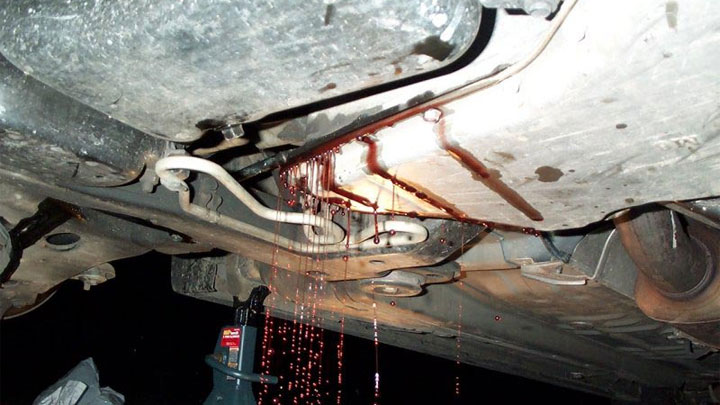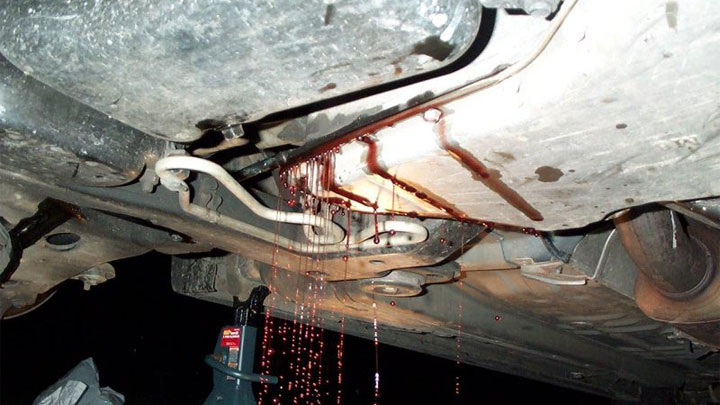
It has happened to most Asian Import owners. You notice a mysterious puddle under your vehicle and quickly go into panic mode not knowing what the fluid is or how serious the leak may be. Knowing how to identify the different types and locations of fluids in your vehicle will help you determine how serious a leak is, and how soon it should be evaluated.
Here is some is some interesting information about the fluids that keep your Asian Import running smooth:
There are many different fluids in your Asian Import including engine oil, engine coolant, transmission fluid, brake fluid, washer fluid, and gasoline. Many vehicles also have power steering fluid, differential fluid, and transfer case fluid. Some motor and transmission mounts contain hydraulic fluid. Shock absorbers and struts also contain hydraulic fluid. It is possible for all of these fluids to leak. Air conditioning systems can leak refrigerant oil in addition to Freon, and when operating properly will also leak water. A battery may leak since it contains a mixture of water and sulfuric acid. Some of these fluids may leak while you are driving, others may leak while the vehicle sits, some may leak while driving and sitting, some leaks are common, and some are rare.
All fluids have certain characteristics which can help you identify them when they begin to leak on your Asian Import. These characteristics include color, consistency, smell, and location. The purpose of this article is to help you understand the different possible types of fluid your vehicle is equipped with, develop a general understanding of what their characteristics are, be informed of components that frequently leak, and recognize a leak before it becomes a huge issue.
Engine oil is the most common leak. An engine oil leak can adversely affect the oil level, and if left unchecked can cause engine damage. New engine oil has a yellowish golden color, while older oil can be dark brown to black. Used engine oil often smells slightly gassy. Components that frequently leak engine oil include engine component gaskets (valve cover, oil pan, intake manifold, timing cover), crankshaft and camshaft seals, oil filter, oil cooler and lines, and the drain plug gasket.
You may notice your vehicle doesn’t drip oil, but rather seeps oil slowly from various parts of the engine. Oil seepage is common in higher mileage vehicles, and you usually don’t lose enough oil between changes to adversely affect the engine. Just keep an eye on seeps, and get them looked at as soon as they turn into wet components, active drips, hanging drops, or puddles.
Coolant is probably the second most common leak. Coolant, also known as antifreeze, can be green, blue, red, bright orange, or pink. It has a bit of a sticky, slimy, viscous feel to it, and generally has a sweet smell. Coolant regulates the temperature in your engine. Left unchecked, a coolant leak can lead to your engine overheating and your vehicle dying on the side of the road. Another reason to have coolant leaks fixed as soon as possible is because coolant is extremely toxic to pets. Coolant leaks generally happen at the front area of the vehicle, but may also occur on the floor under the dash, and at the rear of vehicles equipped with a rear heating system. Components that frequently leak coolant include the radiator, radiator hoses, heater hoses, water pump, thermostat housing, and heater core.
Automatic transmission fluid has a light red color when it is in new condition and a dark red or dark brownish color when it gets older. It is a little thicker and has an almost oil-like feel. It has an odor and may smell slightly burnt if it is older and dark brown. Some manual transmission equipped vehicles use automatic transmission fluid, but most use gear oil or manufacturer specific fluid. Transmission fluid serves as a lubricant so transmission gears shift smoothly and correctly. The fluid also serves as a coolant in the transmission. If your Asian Import gets low on transmission fluid, you run the risk of damaging the transmission. Look for transmission fluid leaks near the front or middle of the vehicle. Transmission fluid leaks commonly come from the transmission component gaskets (pan, side cover, case), seals (axle, shift shaft, output shaft, front pump), cooler lines, and cooler.
Brake fluid is a hydraulic fluid and is clear to yellowish in color, has a medium viscosity, and a slightly oily feel. Brake fluid has a dull, mechanical smell. If you suspect you have a brake fluid leak it should be diagnosed with certainty, even if you need to take it to a repair shop. A brake fluid leak could possibly result in brake failure. This is not something you want to happen as you are cruising down a hill going 60 MPH. Fortunately, in most modern vehicles, brake fluid leaks are rare. If you do have one, you will usually find it near any of the wheels or in the area directly in front of the brake pedal under the hood near the firewall.
Windshield washer fluid is usually blue, but sometimes green, orange, or pink. It is thin and feels almost like water. Washer fluid has a slightly sweet smell similar to a mix of coolant and window cleaner. Check the windshield washer fluid reservoir, tubes, and rubber hoses that carry fluid to the sprayers for any leaks. This is not a serious leak. However, it does become a problem when you splash through a muddy puddle and can no longer see.
In a hydraulic power steering system, a drop in your power steering fluid level will result in a whining or growling noise and a loss of power steering assist or stiff steering. Some vehicles actually use a red automatic transmission fluid as the power steering fluid, while other vehicles use a power steering fluid specified by the manufacturer. It is generally slightly yellowish and has a medium thickness. It has very little smell, but a keen nose will detect a dull, mechanical scent. Check your owner’s manual to find out what your vehicle uses for power steering fluid. Your vehicle’s steering system is towards the front of the vehicle, so you will find evidence of power steering leaks there. Common sources for a power steering fluid leak include the power steering pump, hoses connecting the power steering system, and the steering gear.
Four-wheel drive or all-wheel drive vehicles may develop leaks from differentials and the transfer case. The transfer case and differentials may be filled with gear lubricant or manufacturer specific fluid. Gear lubricant is light brown to dark brown depending on the amount of use it has had. It is a heavier, thicker oil and has a pungent odor. A differential or transfer case may leak from seals and gaskets. The transfer case is usually mounted at the center of the vehicle, and the differentials are at the front and rear of the vehicle.
Here are a few more reasons you might see fluids leaking from your Asian Import:
Struts and shock absorbers contain hydraulic fluid which helps cushion the ride while you are driving. As these components age, they will eventually leak and lose their effectiveness which will cause a rough ride and cupped tire tread. The fluid in shocks and struts is usually yellowish to clear and has the consistency of light oil. It will generally have a slight mechanical odor. This leak will flow down the outside of the component directly beneath the strut or shock and is easily verified when visually inspected.
Imagine it is a really hot day and you have had your vehicle’s air conditioning running full blast all day. As you walk towards your vehicle, you notice a steady drip of liquid coming from underneath the passenger dash area onto the ground. You touch it, smell it, look at it, and it appears to be water. This is one leak that is normal. It is in fact just water condensation coming from the air conditioning evaporator drain tube and nothing to worry about. Air conditioning systems may also leak refrigerant oil, which will generally show up as an oily residue seep possibly coming from the air conditioning compressor, component fittings, seals, or crimp connections on hoses.
As your Asian Import gets older, it will eventually develop fluid leaks and leave ominous spots or puddles on the ground. The good news is you can improve your ability to decipher those mysterious spots, which will help you determine whether the fluid leak is harmless or a serious problem needing to be fixed. It is important to be aware of where you typically park and watch for evidence of leaks. Place cardboard under your vehicle so you can analyze the color, consistency, smell, and location of the leak. Remember, fluid seeps are generally not a concern, but they should be watched.
If your vehicle shows evidence of a leak and you cannot tell for sure what it is or where it is coming from, have Automotive Instincts find out where the leaks on your Asian Import is coming from.
Automotive Instincts19831 Ventura Blvd Woodland Hills, CA 91364
(818)883-4172

#ATeamYouCanTrust#yelp#family#TheBestMechanic#googlereviews#nextdoor#peopleloveusonyelp#mechanic#maintenance#asianautomobile#japanese#CabinFilter#AirFilter#automotiveinstincts#suspension#brakejob#oilchange#teamaiwoodlandhills#WeCare#honestmechanic#trustworthy#woodlandhills#infiniti#Nissan#autorepairshops#Lexus#mazda#Toyota#Honda#asianimportspecialist
